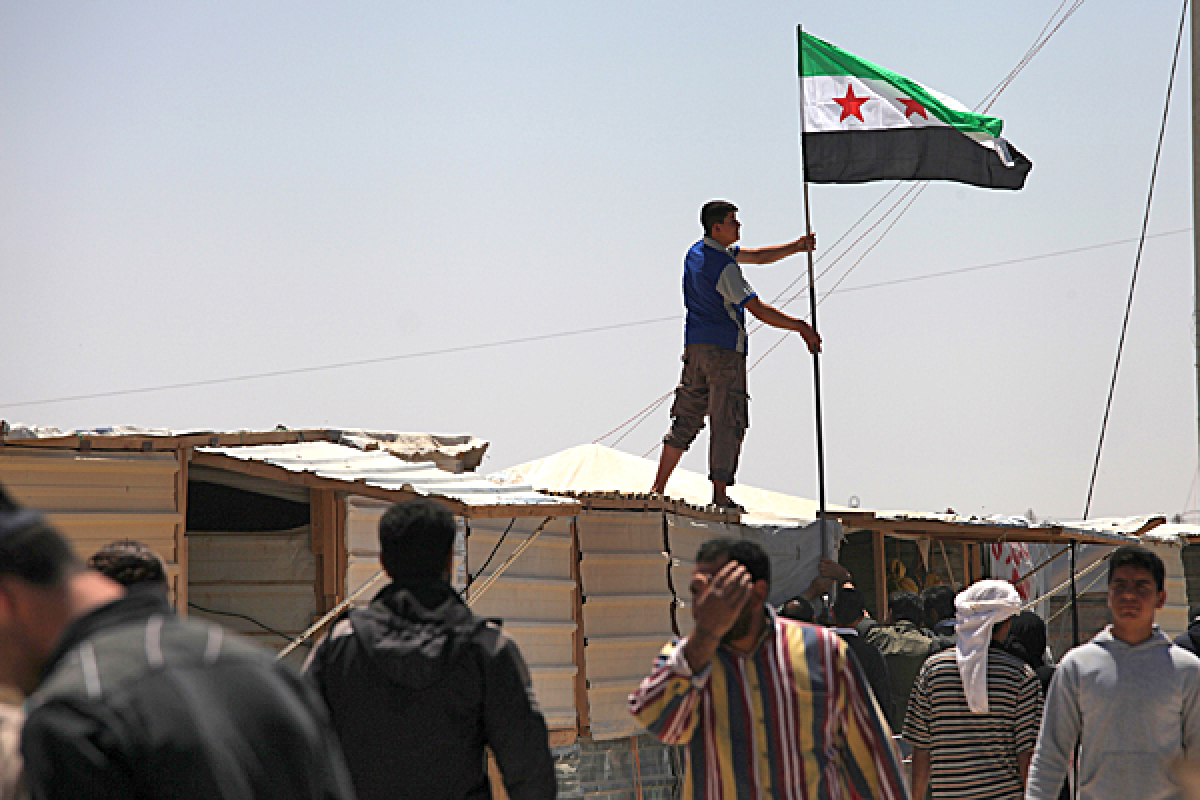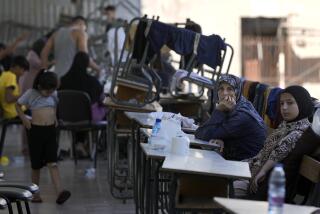Syria refugees resume flow into Jordan after lull

- Share via
AMMAN, Jordan — Refugees from war-ravaged Syria began trickling back into Jordan on Saturday, a week after a more than two-year exodus had all but ceased, raising fear of thousands of Syrians stranded in the battle zone.
Jordanian officials denied reports that its border guards had turned back refugees. Jordan said heavy fighting on the Syrian side had blocked access to the frontier, a vital escape valve for Syrians fleeing the nation’s civil war.
Jordanian analysts and some officials, however, have said privately that the government had indeed largely sealed the border to refugees, perhaps as a security measure or to help attract more international aid. A Jordanian military official who declined to be named confirmed the shutdown, saying that only those with severe wounds or other health emergencies were allowed in last week.
“We received orders to let only 60 people enter per day,” said the military official, who is knowledgeable about security in the border zone but wasn’t authorized to speak publicly. “The strain was too much, and there was abuse of the situation by some people.”
The United Nations reported that 141 refugees had crossed into Jordan early Saturday and were being housed in the severely overcrowded Zaatari camp, 15 miles south of the Syrian line. That was the highest daily figure in a week.
The number remained way down from the average of 1,500-2,000 Syrians who had been crossing daily before May 18. From May 18 to May 24, only 35 Syrians managed to cross into Jordan, a dramatic contrast to the first two weeks of May, when more than 25,000 did, according to U.N. figures.
The refugee influx into neighboring nations has become the most dramatic example of how the Syrian crisis has spilled over its borders.
The reason behind last week’s plummeting refugee arrivals in Jordan remains a matter of heated dispute.
“The refugees aren’t coming because there is intense fighting in the area,” said Anmar Hmoud, who heads a Jordanian government committee dealing with the influx. “The border remains open, no matter what anyone is saying.”
The weeklong slowdown came amid reports of heavy fighting near the main unofficial crossing point of Tal Shehab, one of three principal refugee corridors in southern Syria, which shares a more than 200-mile frontier with Jordan.
The government’s longtime open-door policy to refugees, lauded by international aid agencies, has come under mounting criticism at home. The refugee issue has become an intensely politicized issue in Jordan. The kingdom now hosts more than 600,000 Syrian refugees, who represent both a financial burden and a source of potential instability. An additional 250,000 Syrians are likely to flee the violence in their country in coming months, according to official Jordanian estimates.
A renewed influx could drive Jordan “to the breaking point,” said Fahed Khitan, a political analyst here.
“There has been significant internal pressure, with many members of parliament and former prime ministers pleading with the government to change its open-border policy with regards to Syria,” Khitan said.
In a speech Saturday, Jordan’s King Abdullah II said a political solution was urgently needed to ease the refugee crisis.
“Our Jordanian population is now hosting 10% of its size in Syrian refugees, and this may double by year’s end,” Abdullah told an economic forum.
On Friday, the U.N. refugee agency expressed concern “about reports that many Syrians trying to flee may be backed up at the borders in areas that are extremely dangerous.” It called on all parties “to protect civilians and allow safe passage for those wishing to flee,” Melissa Fleming, chief spokeswoman for the U.N. agency, said in a statement from Geneva.
The U.N. did not point the finger at Jordan or Syria’s other refugee-burdened neighbors: Lebanon, Turkey and Iraq. But the huge refugee flows — more than 1.5 million people have fled Syria — have become an explosive issue across the region, sapping national resources and escalating social tension.
Nowhere is this volatility more evident than in Jordan’s sprawling Zaatari camp, which has been transformed in less than a year from a desultory stretch of lunar-like desert into the equivalent of Jordan’s fifth-largest metropolis, a city of more than 150,000 — where no one wants to be.
The massive expanse of tents and trailers has been the scene of riots, arising in part from its harsh conditions: dust storms and scorching heat in summer and sub-zero temperatures, snow, flooding and muddy quagmires in winter. The camp has become a bleak symbol of the refugees’ plight and the burden that the uprooted people of Syria represent for Jordan’s scarce resources.
On Saturday, border-area residents confirmed that Syrians fleeing the war were arriving anew in northern Jordan, albeit in greatly reduced numbers.
“Now it’s open again, but these past few days ... people were still coming but they weren’t allowed in,” said Mohammad, a border-area smuggler and guide who asked that his surname not be used for security reasons. “Really, we think it was a way for the government to pressure the international community.”
Bulos is a special correspondent. Times staff writer Patrick J. McDonnell in Beirut contributed to this report.
More to Read
Sign up for Essential California
The most important California stories and recommendations in your inbox every morning.
You may occasionally receive promotional content from the Los Angeles Times.











